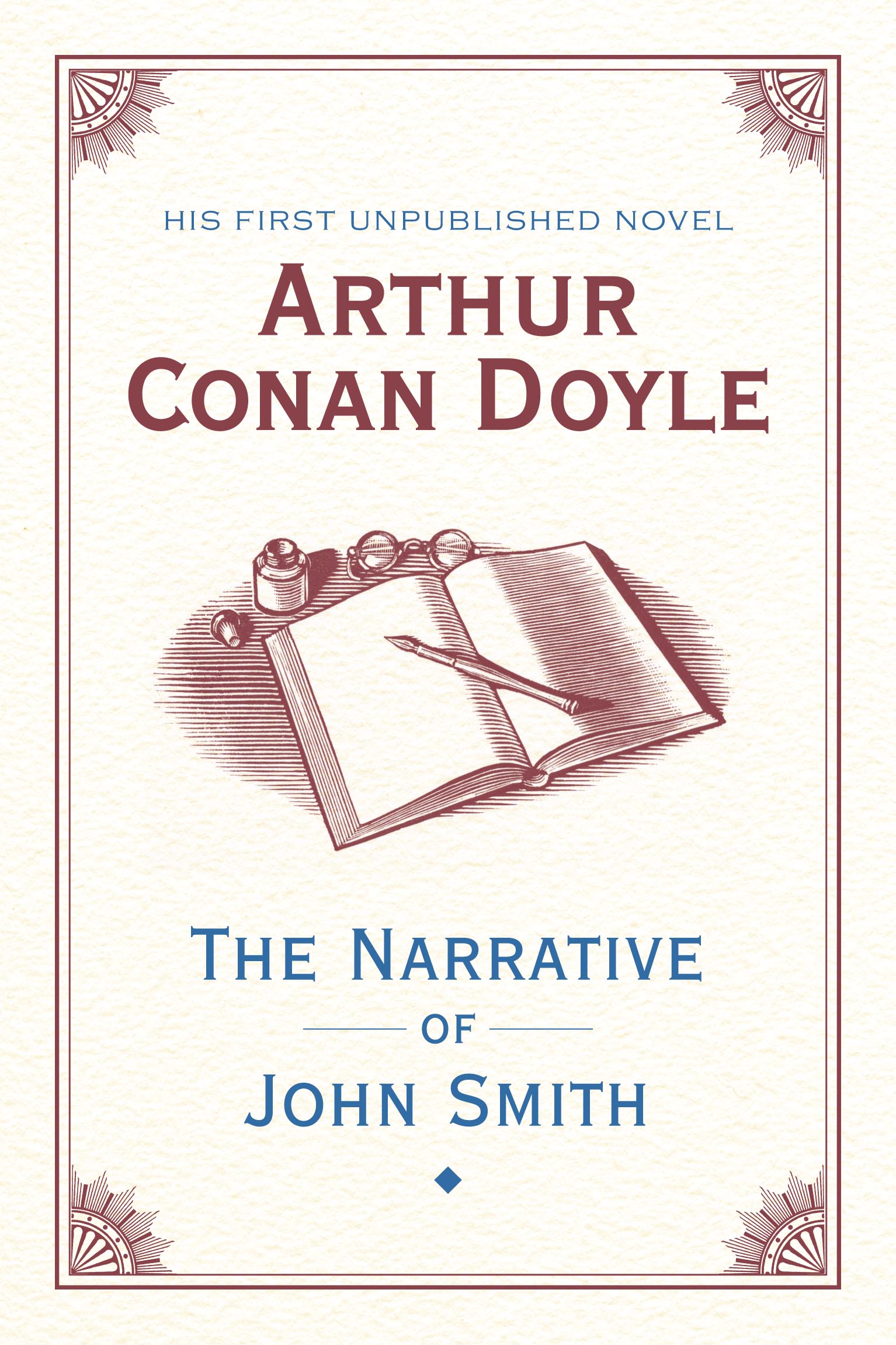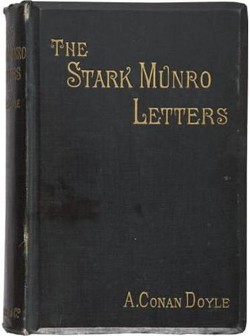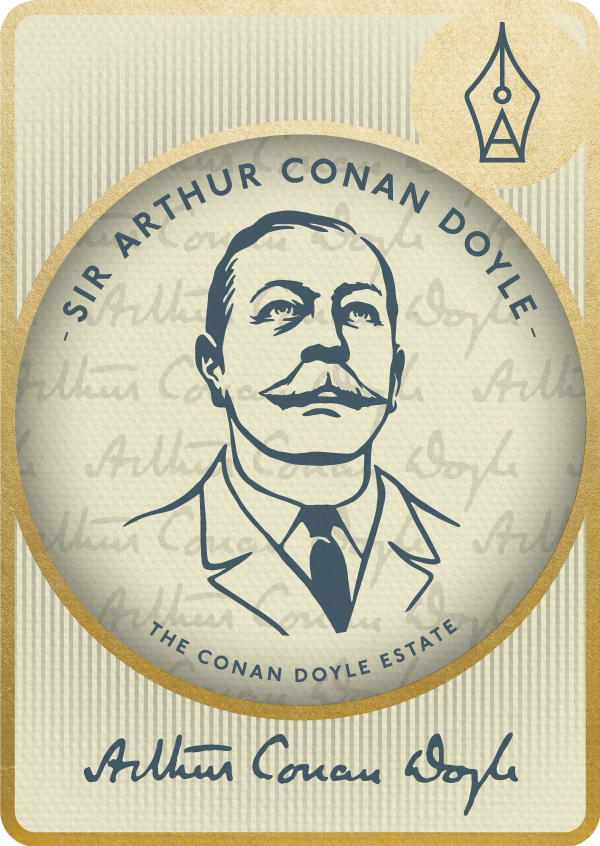 The young struggling physician in Southsea, Portsmouth, in the 1880s, when writing The Narrative of John Smith.
The young struggling physician in Southsea, Portsmouth, in the 1880s, when writing The Narrative of John Smith.
 Cover of The Narrative of John Smith -- the annotated edition of Conan Doyle's rewritten manuscript, published in 2011 by the British Library where the manuscript now is.
Cover of The Narrative of John Smith -- the annotated edition of Conan Doyle's rewritten manuscript, published in 2011 by the British Library where the manuscript now is.
 First edition of Conan Doyle's most autobiographical novel, published in 1895.
First edition of Conan Doyle's most autobiographical novel, published in 1895.
Conan Doyle molded his own character with as much care and ambition as those of Holmes, Brigadier Gerard, Professor Challenger, or any of his fictional heroes. “He seemed to us,” wrote his daughter Jean, “to be the very personification of the chivalry of the stories of King Arthur’s Round Table.”
In December 1927, The Strand Magazine posed an intriguing question to its leading contributors: “What character, in all of literature, would you most like to have created, and why?” This “fearful question” drew a lively catalog of answers. H. G. Wells put forward Shakespeare’s Falstaff, Compton Mackenzie admired Don Quixote, and D’Artagnan, Don Juan, and Robinson Crusoe were raised by other prominent writers.
Sir Arthur Conan Doyle, whose Sherlock Holmes had propelled The Strand to prominence, gave perhaps the most unexpected response. Instead of a gallant adventurer or intellectual pioneer, he chose Thackeray’s Colonel Newcome, a character synonymous with chivalry and virtue—a selection, The Strand was quick to point out, characteristic of Conan Doyle “as a writer and a man.” Colonel Newcome, Conan Doyle explained, was “an ideal English gentleman.”
It is, of course, a trifle, but as Sherlock Holmes tells us, there is nothing so important as trifles. Like the portrait of Henry Ward Beecher in Baker Street, Conan Doyle’s choice allows us to follow a train of thought linking an admired figure to personal experience. It requires no great leap of deductive skill to say that Conan Doyle’s esteem for the virtuous and upstanding Colonel Newcome found expression in his own life, striving to conduct himself as an ideal English gentleman.
Holmes, in a disputatious mood, might argue that Conan Doyle was not, strictly speaking, an Englishman—in fact born in Scotland to parents of Irish extraction, the two cultures forming a proud and sturdy thread in the tangled skein of his identity. “I am half Irish,” he once remarked, “and my British half has the devil of a job to hold the hot-headed rascal in.”
For him, the matter was rooted in tales of English knights and quests his mother told him as boy, sparking his imagination and instilling a sense of tradition and honor.
Those fondly-remembered tales helped shape his career as an author, especially in the historical novels he hoped “would illuminate our national traditions.” At the same time, they set forth a code of behavior he sought to embody in his own life. In that sense Conan Doyle molded his own character with as much care and ambition as those of Holmes, Brigadier Gerard, Professor Challenger, or any of his fictional heroes. “He seemed to us,” wrote his daughter Jean, “to be the very personification of the chivalry of the stories of King Arthur’s Round Table.”
Conan Doyle would likely object. “I cannot agree with those who rank modesty among the virtues,” Sherlock Holmes once declared, but his creator was self-effacing to a fault. “It is naturally repugnant for a man to stand up on a public platform and to talk about himself and his own work,” he declared during his American speaking tour in 1894, “for never until a man attempts to do so before an audience does he realize how very insignificant both himself and his own works are.” And with the notable exception of Memories and Adventures, his engaging autobiography written late in life, Conan Doyle’s published work seldom drew overtly on his inner life or personal experiences. However, there were two notable exceptions: an early, ill-fated work called The Narrative of John Smith, and a more fully-realized novel, The Stark Munro Letters, published in 1895.
The Narrative of John Smith Conan Doyle would later describe, rather grandly, as having a “personal-social-political complexion.” When he set to work on it at age 23, he was a recent medical school graduate struggling to establish a practice in Southsea, Portsmouth. In many ways it’s remarkable he found time to attempt a full-length novel. He’d been earning extra money as a writer since his student days, sending stories and articles to the leading literary journals of the day as he worked to build up his practice, dividing his time between medicine and literature. (“It is hard to say which suffered most,” he later joked.)
His earliest story, “The Mystery of Sasassa Valley,” in Chambers’ Journal in September 1879, had earned him the princely sum of three guineas, and “After receiving that little cheque I was a beast that has once tasted blood,” he said. In time, however, he came to realize that his literary ambitions could only be fulfilled by a novel. “What is necessary is that your name should be on the back of a volume,” he wrote in a letter to his mother: “Only so do you assert your individuality and get full credit or discredit of your achievement.”
The Narrative of John Smith, his first attempt to navigate the transition from short-story writer to novelist, features a middle-aged man laid up in a boarding-house, ruminating over a variety of matters constituting the themes of the book. Though John Smith is a retired army major, and world-weary figure, his lengthy meditations touch on aspects of religion, medicine, and human nature that closely reflected the views of his 23-year-old author.
At one stage, Smith turns his attention to the writing of short stories, a subject his creator was able to address with authority. “I flatter myself that I am somewhat of a connoisseur of short stories,” Smith allows. “The wine-taster uses a liqueur glass, not a tumbler, and so the real flavour of an author can be appreciated best in his smaller productions. But how few there are who have written first-class tales. You could count them on your fingers. The reason is, I suppose, that when an author has hit upon a strong idea which may be amplified into a three-volume novel he cannot afford to throw it away upon a thirty-page story. Yet to my mind, the production of the short tales is the finer art of the two. Every little gem must be of the purest water and most delicately cut if it is to stand out among its fellows. There is no room for padding — every word must tell.” These observations came before Sherlock Holmes, whose success owed much to his creator’s mastery of the short story form, but it was a view Conan Doyle maintained throughout his career. “This I am sure of,” he would write in Through the Magic Door, his 1907 book about books, “that there are far fewer supremely good short stories than there are supremely good long books. It takes more exquisite skill to carve the cameo than the statue.”
John Smith also expounds at length on the difficulties of finding success in the literary field, clearly reflecting the young author’s frustrations. “Literature is a very tempting oyster for a smart young man to open, but your knife is apt to break short off before you get into it,” Smith observes: “If the secret history of literature could be written, the blighted hopes, the heart-sickening disappointments, the weary waiting, the wasted labour, it would be the saddest record ever penned.”— a sentiment never far from Conan Doyle’s mind in his years of struggle. When a short time later, as his first Sherlock Holmes tale A Study in Scarlet gathered rejection slips, he echoed Smith’s complaint in a letter to his mother: “Verily literature is a difficult oyster to open.”
In describing his own efforts as a fledgling writer, Smith speaks of bundling up a manuscript to send to a London publisher—“duly packed, addressed, and registered, with every conceivable precaution against its miscarrying.” Here, Conan Doyle drew on bitter experience: in spite of every conceivable precaution, the original manuscript of John Smith had in fact miscarried. “Alas for the dreadful thing that happened!” he exclaimed ten years later: “The publishers never received it, the Post Office sent countless blue forms to say that they knew nothing about it, and from that day to this no word has ever been heard of it. Of course it was the best thing I ever wrote. Who ever lost a manuscript that wasn’t?”
It was definitely not the best thing he ever wrote. Although it affords an intriguing glimpse of Conan Doyle’s apprentice period, The Narrative of John Smith lacked the narrative drive and story-telling technique distinguishing his later efforts. At the time, however, he could not shrug off the loss. “No, I never got poor John Smith,” he told his mother in 1884, but “I am going to rewrite him from memory.” And he made a valiant effort, producing some 154 pages of new manuscript, but eventually he abandoned the project. For the rest of his life he would scavenge passages of the incomplete novel, often verbatim, for use in later works. In particular, he inserted many ideas and incidents from John Smith into The Stark Munro Letters, published in 1895, with canny revisions that showcased his growth as a writer.
The Stark Munro Letters is easily Conan Doyle’s most autobiographical novel. It tracks the misadventures of a recent medical school graduate attempting to launch an unconventional practice with his brilliant but wildly eccentric friend Cullingworth. Conan Doyle later stated that his novel “drew in very close detail” on his own brief, tempestuous medical partnership with an Edinburgh classmate named George Budd, “half genius and half quack.” Though the novel’s focus rests largely on Budd’s outlandish exploits, the reader also gains insight into the character of the narrator as he grapples with questions of religion and philosophy. Unlike Smith, who addresses similar concerns from the perspective of an older, becalmed figure, Stark Munro is a young man struggling to find his place in the world, imparting an atmosphere of urgent energy to these internal struggles.
In particular, the religious views expressed by Stark Munro closely mirror those of Conan Doyle, whose “spiritual unfolding” had caused a rift with his more devout Roman Catholic relations. “When I first came out of the faith in which I had been reared,” Munro confesses, “I certainly did feel for a time as if my life-belt had burst.” In spite of this, however, Munro poses a bold set of challenges to religious convention. “Is religion the only domain of thought which is non-progressive,” he asks, “and to be referred forever to a standard set two thousand years ago? Can they not see as the human brain evolves it must take a wider outlook? A half-formed brain makes a half-formed God, and who shall say that our brains are even half-formed yet?”
Conan Doyle was keenly aware that these were controversial notions, later acknowledging that perhaps the loss of his earlier manuscript had been best for all concerned. “I must in all honesty confess,” he wrote, “that my shock at its disappearance would be as nothing to my horror if it were suddenly to appear again — in print.” For all that, the rewritten pages offer valuable insight into forces shaping his character as a young man, and give evidence of the open, trusting nature that would soon lead him to experiment with spiritualism as an alternative to traditional beliefs. “I am, I think, one of the most unsuspicious men upon earth,” Stark Munro remarks at one stage, “and through a certain easy-going indolence of disposition I never even think of the possibility of those with whom I am brought in contact trying to deceive me. It does not occur to me.”
Perhaps it is foolish, though, to assign autobiographical significance to the plugs and dottles Conan Doyle scattered throughout these early writings. One recalls the famous opening scene of The Hound of the Baskervilles, in which Holmes, upon learning that an anonymous visitor has left behind his walking stick instead of his calling-card, invites Watson to gather clues from it. “Let me hear you reconstruct the man,” says the detective. Watson, attempting to apply his friend’s methods, offers a series of plausible conjectures, building a portrait of a middle-aged country medical practitioner. But Holmes corrects Watson in glorious detail, concluding that the owner of the stick is actually “a young fellow under thirty, amiable, unambitious, absent-minded, and the possessor of a favourite dog, which I should describe roughly as being larger than a terrier and smaller than a mastiff.”
Perhaps it is a tribute to Conan Doyle’s famous creation that so many of the author’s admirers have attempted similar feats, hoping to reconstruct the man from the clues he left behind.
--
Daniel Stashower is the author of the award winning Teller of Tales: The Life of Arthur Conan Doyle, and co-editor as well of Arthur Conan Doyle: A Life in Letters, The Narrative of John Smith, and “Dangerous Work”: Diary of An Arctic Adventure. He is a professional writer, a member of the Baker Street Irregulars, and a three-time winner of the Edgar Award from the Mystery Writers of America.

